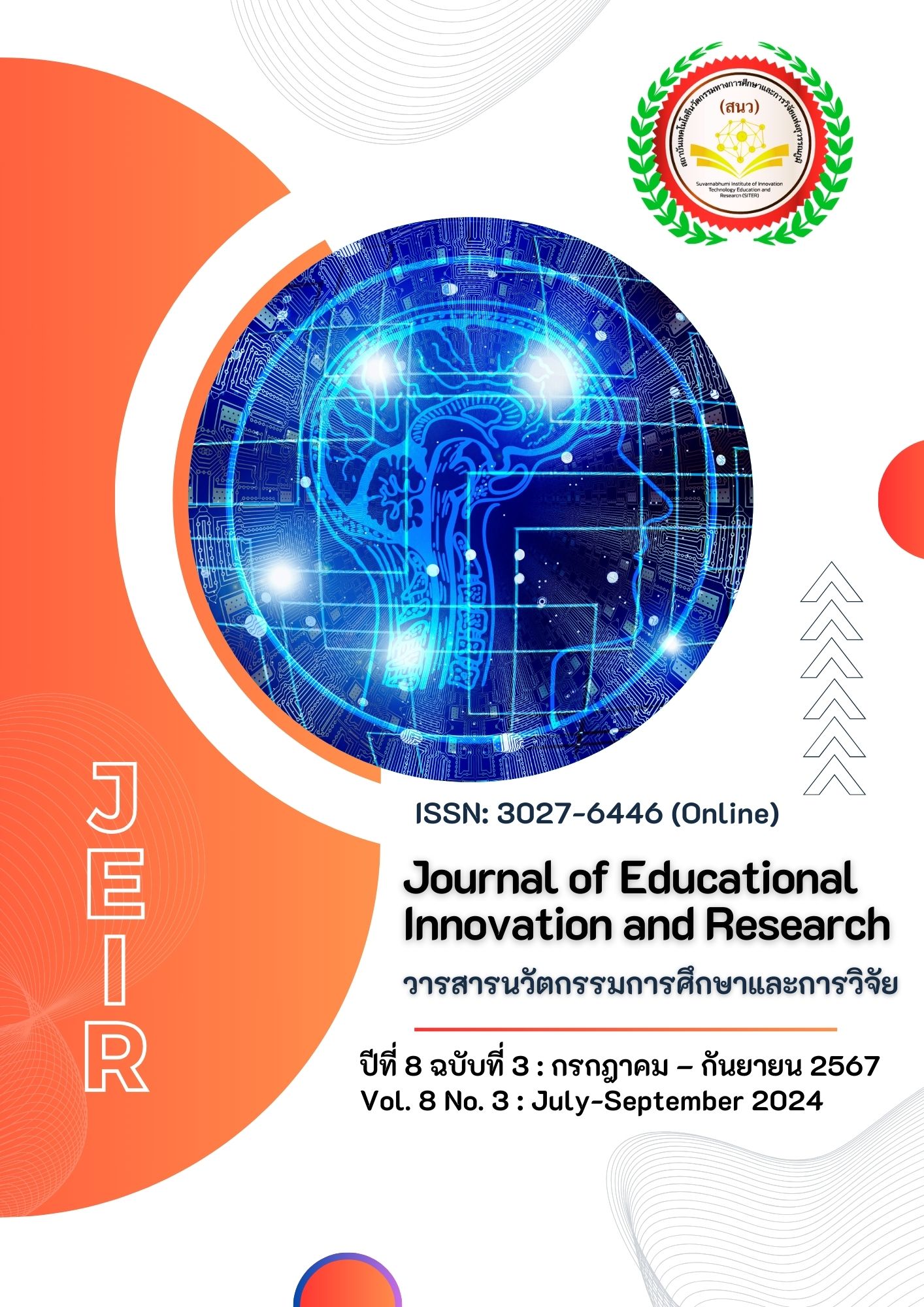Administration of the Educational Institutions that Promote the Operations of Student Affairs under the Secondary Educational Service Area Office, Area 1
Main Article Content
บทคัดย่อ
This article objective to: 1. study the administration of the educational institutions that promote the operations of student affairs under the Secondary Educational Service Area Office, Area 1; 2. compare the opinions of the administrators and teachers regarding the administration of the educational institutions that promote the operations of student affairs under the Secondary Educational Service Area Office, Area 1; and 3. research suggestions for educational institution management that support the management of the school's student issues. The population consisted of 5,002 administrators and teachers, out of which there were 298 respondents. The instrument used was a questionnaire with three parts. The tools used are questionnaires, statistics, frequency distribution, percentage, Mean, standard deviation, comparing one-way ANOVA, and content analysis.
The research results were found as follows:
- Overall, the administration of the educational institutions that promote the operations of student affairs in all five dimensions was conducted at a high level. The study of each dimension showed that staffing was conducted at a high level, followed by leadership and control, respectively.
- The comparison of the opinions revealed that the administrators, group leaders, and teachers with different job positions and different education levels did not have different opinions on the administration of the educational institutions that promote the operations of student affairs.
- Suggestions for educational institution administration that promote student affairs operations Planning should provide opportunities for those involved in student affairs to participate in plans that are consistent with student affairs operations. Organizing should continually develop skills and knowledge for student development. Leadership should systematically monitor performance according to the learner development plan. Personnel management should create a collaborative network of parents, communities, and other agencies. for student development. Control should use the PDCA operating system. to organize student affairs and continuously monitor them.
Knowledge/findings from this research: School education administration indeed relies on management principles across five key dimensions: planning, organizing, leadership, personnel management, and control. Among these, personnel management holds particular significance for student affairs management. Educational institution administrators can effectively apply personnel management principles to promote student affairs through factors such as: 1. Participation from All Sectors: Encouraging active involvement and collaboration from various stakeholders ensures that student development efforts align with the overarching goals set by the educational institution. 2. Empowerment and Support: Empowering personnel involved in student affairs with the necessary resources, authority, and support enables them to execute their responsibilities effectively. 3. Communication: clear communication and motivation facilitate transparency and accountability, fostering a collaborative environment conducive to achieving desired outcomes. 4. Professional Development: Investing in the professional development of personnel involved in Student affairs equips them with the skills, knowledge, and competencies necessary to address the diverse needs of students effectively. Continuous learning opportunities enhance their capacity to support student growth and success.
Article Details

อนุญาตภายใต้เงื่อนไข Creative Commons Attribution-NonCommercial-NoDerivatives 4.0 International License.
เอกสารอ้างอิง
Allen, L.A. (1958). Management and Organization. Mc Graw-hall. The University of Michigan.
Brown, W. & Moberg, D. (1980). Organization Theory and Management: A Macro Approach. New York: John Wiley and Sons.
Campbell, R. F. (1972). Introduction to Educational Administration. New York: Allyn & Bacon.
Certo, C. S. (2003). Modern Management (9th ed.). New Jersey: Pearson Education.
Chunthaisri, k., Ployduangrat, J., Chatrakamollathas, S. (2013). A Study of Student Personal Administration of Administrators in Primary Schools under District Bangkok Metropolitan (Eastern Bangkok Group). Journal of Education Research,7(2), 22-35.
Clifton Office for Standards in Education. (2003). Inspecting schools: Framework for inspecting schools. London: Ofsted Publications Centre.
Cronbach, L. J. (1990). Essentials of psychological testing (5th ed.). New York: Harper Collins Publishers.
Fayol, H. (1972). The Administrative Theory in the State. In Papers on the Science of Administration. (2nd ed.). Edited by Luther Gulick and L. Urwick. New Jersey: Augustus M. Kelley.
Khakhai, N. (2019). The Management of Student Activities Section Using Participatory Approach of Chiangmai Thepbodint Withaya School [Doctoral dissertation, Chiang Mai University].
Leeprom, N. et al. (2016). The Development of a Model on the Student Affairs Management in Schools under the Office of Sakon Nakhon Primary Educational Service Area 3: A Case Study of Club Activities, Activities on Scouts, Girl Scout-youth Red Cross and Student Council Activities. Journal of Graduate School. Sakon Nakhon Rajabhat University,13(63), 49-58.
Lunenburg, F. & Ornstein, A. C. (1996). Educational Administration: Concepts and Practices (2nd. Ed.). New York: Wadsworth.
Luther, G. & Luther, L. U. (1973). Papers on the Science of Administration. New Jersey: Institute of Public Administration.
Malinee Kesthanakorn. (2013). Student affairs administration according to Buddhist governance principles for educational personnel. Secondary schools are under the jurisdiction of the Secondary Educational Service Area Office 42 [Master’s Thesis, Mahachulalongkornrajavidyalaya University].
Ministry of Education. (2013). School Administration Manual in Management Development Project, Independent School Model, Operating in Educational Management Promotion Group. Ministry of Education.
Panbunhom, P. (2012). Student Affairs Administration, Mahidol University, Phutthamonthon District. Nakhon Pathom Province [Master’s Thesis, Mahachulalongkornrajavidyalaya University].
Pathanaudomsinka, P. (2014). The Administrative Process Model Affecting the Educational Quality Development in Basic Education Schools [Doctoral dissertation, Kanchanaburi Rajabhat University].
Phetcharot, L. and Chaniprasat, A. (2002). Research methods. Bangkok: Typdee Printing Company.
Phokumnird, S. (2015). A Study on Problems and Guidelines for the Development of Student Affairs Management in Agriculture and Technology College under The Office of Vocational Education Commission. [Master’s Thesis, Pibulsongkram Rajabhat University].
Sergiovanni, J. T. (1991). The principal ship: A reflective practice perspective. (2nd ed.). Needham Heights: Allyn and Bacon.
Soontradejangkoon, K. (2013). A Study of Student Affairs Administration Problems by the Vision of Administrators and Teachers, Primary Education Service Area Offices in Lopburi [Master’s Thesis, Thepsatri Rajabhat University].
Thongcharoen, W. (2012). The role of educational institution administrators. https://www.gotoknow.org/ posts/484673


